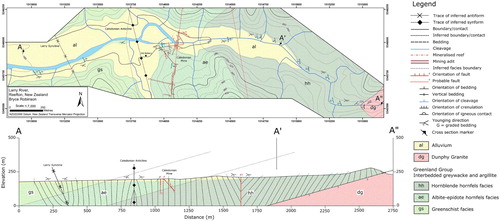ABSTRACT
The 378–370 Ma Dunphy Granite has contact metamorphosed Greenland Group metasedimentary rocks in the Awarau/Larry River valley in the northernmost portion of the Reefton Goldfield in Westland. Hornblende hornfels facies Greenland Group occurs up to ∼1300 m of the granite contact, followed by albite-epidote hornfels facies assemblages between ∼1300 and 2000 m from the granite, after which the rocks retain Early Paleozoic greenschist facies assemblages. The historic Caledonian goldmine is located on a fault zone within hornfels facies rocks. There is a complex mineralisation paragenesis in samples obtained from the mine area in which quartz, gold, arsenopyrite, pyrite with minor galena and chalcopyrite formed in quartz veins and brecciated Greenland Group. Fractures in the early-formed minerals and rocks contain quartz, minor galena and molybdenite and oligoclase and biotite. Although the poor exposure and collapsed mine workings prohibit firmly establishing the relationship of mineralisation to the contact aureole, hand specimen and optically observed textures indicate that mineralisation is hosted in a brittle fault zone that most likely cuts across the hornfels facies rocks. Mineralisation is therefore interpreted to post-date formation of the Late Devonian contact aureole at 378–370 Ma.
Introduction
The timing of gold mineralisation in the Reefton Goldfield in Westland () is poorly constrained. An uppermost age is marked by the deposition of the host Greenland Group between 482 and 475 Ma (Cooper Citation1974). The lowermost age is bounded by the deposition of the unconformably overlying Eocene Brunner Coal Measures (Gage Citation1948), and tentatively constrained to before emplacement of a ∼119 Ma granitoid dike in Blackwater Creek (Dickie et al. Citation2018). This leaves a period of ∼350 Ma in which mineralisation could have occurred.
Figure 1. Regional geological map of north Westland. The area of study, Arawau/Larry River, occurs in the northernmost portion of the Reefton Goldfield. Maps are adapted from Nathan et al. (Citation2002).
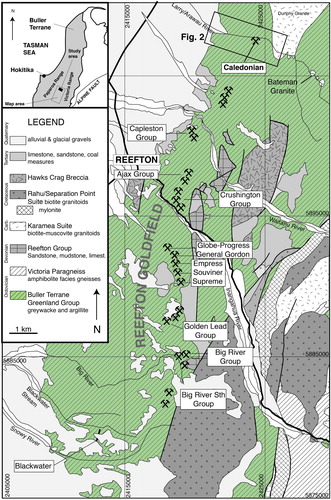
It is well established that gold in the Reefton Goldfield is associated with quartz, pyrite and arsenopyrite ± stibnite in fault zones and their alteration haloes (Henderson Citation1917; Gage Citation1948; Christie and Brathwaite Citation2003; Bierlein et al. Citation2004; Milham and Craw Citation2009; MacKenzie et al. Citation2014; Shand et al. Citation2015; Hamisi et al. Citation2017; Allibone et al. Citation2018). Paragenetic studies have established that there are broadly two events: a ductile phase with minor gold and arsenopyrite that is commonly overprinted by a brittle phase with abundant quartz, gold, arsenopyrite and antimony (Christie and Brathwaite Citation2003; Milham and Craw Citation2009; MacKenzie et al. Citation2014; Shand et al. Citation2015; Allibone et al. Citation2018). Both styles appear to have similar orientations, except at Globe-Progress () where the shear-hosted mineralisation is discordant to the general prevailing N–S strike (Gage Citation1948; Rattenbury and Stewart Citation2000; Allibone et al. Citation2018).
The general subparallel trend of the mineralised shears to Greenland Group fold axial planes has led to the suggestion that mineralisation occurred during regional folding (Christie and Brathwaite Citation2003). Folding predates intrusion of widespread Late Devonian granitoids in Westland, and mineralisation has been assumed to have occurred at c. 440 Ma on the basis of K–Ar dates (Adams et al. Citation1975) and similarities with orogenic gold mineralisation of about this age in correlative host rocks in the Lachlan Fold Belt in Australia. This interpretation is augmented by the presence of the Devonian sedimentary Reefton Group (Bradshaw Citation1995), which is thought to be unmineralised and to unconformably overlie Greenland Group (MacKenzie et al. Citation2014). However, gold mineralised shear zones in Reefton cut across the axial planar cleavages associated with the macroscopic folds (Rattenbury and Stewart Citation2000; Allibone et al. Citation2018), Adams & Kelley (Citation1998) have shown that low-grade Westland K–Ar samples contain inherited Ar which questions the geochronological significance of the c. 440 Ma metamorphic age, and only fault contacts between the Reefton Group and Greenland Group are exposed (Bradshaw Citation1995). Therefore, post-middle Devonian mineralisation cannot yet be ruled out.
Leach et al. (Citation1997) suggested that gold mineralisation in the Reefton Goldfield may be associated with igneous intrusions even though the Greenland Group is intruded by only a few magmatic rocks (mostly in the form of mafic dikes, and also occasional felsic dikes). This view has gained little traction because (1) mineralisation associated with igneous rocks elsewhere in the region typically also shows elevated Sn, W, Mo and/or Cu (Pirajno and Bentley Citation1985; Kutsukake Citation1988; Shand and Scott Citation2016) and (2) the gold deposits are elongate and show a close association with fault zones (Milham and Craw Citation2009; MacKenzie et al. Citation2014; Shand et al. Citation2015; Hamisi et al. Citation2017; Allibone et al. Citation2018). The only demonstrable occurrence of igneous-related mineralisation occurs in the southern portion of the goldfield in association with a small Early Cretaceous dike, where there is a clear enrichment in Mo (Dickie et al. Citation2018).
The Reefton Goldfield element association of Au–As ± Sb and minor Cu and Pb is typical of orogenic-style mineralisation (Bierlein et al. Citation2004), which results from the dehydration of the middle to lower crust and mobilisation of metal-bearing fluids (Groves et al. Citation2003). Monazite U–Th–Pb dating has established that deeper portions of the Greenland Group in central and southern Westland experienced amphibolite facies metamorphism between 371 and 343 Ma (Scott et al. Citation2011; Palmer et al. Citation2015), and amphibolite facies metamorphism in the Waipuna Valley just south of the goldfield occurred at 108 Ma (Ritchie et al. Citation2015). Thus, assuming an orogenic style of mineralisation, the Late Devonian–Early Carboniferous or Early Cretaceous are likely age candidates for the time of gold mobilisation. However, crosscutting relationships may permit the age range to be refined, and here we examine the relationship of gold mineralisation to the contact aureole surrounding the Late Devonian (378–370 Ma; Muir et al. Citation1996; Turnbull et al. Citation2016) Dunphy Granite in the Awarau/Larry River valley in the northernmost portion of the goldfield.
Geological background
Orogenic gold mineralisation in the West Coast region is mostly hosted in Greenland Group, which is the dominant sedimentary unit in the Buller Terrane in New Zealand (Cooper Citation1989) (). The Greenland Group consists of metamorphosed Ordovician inter-bedded quartz-rich metamorphosed mudstones and sandstones (Laird and Shelley Citation1974; Roser et al. Citation1996; Mortimer et al. Citation2013; Palmer et al. Citation2015; Ritchie et al. Citation2015; Hamisi et al. Citation2017; Dickie et al. Citation2018). The metamorphic minerals (chlorite, muscovite, calcite, albite) in the most widespread lithologies, meta-sandstone and meta-mudstone, indicate the attainment of lower greenschist facies conditions (Type 1 of Ritchie et al. (Citation2015)). Greenland Group rocks in the Reefton are deformed into tight but generally upright macroscopic folds that trend northwards (Gage Citation1948; Rattenbury and Stewart Citation2000).
Plutons regionally intruding Greenland Group in Westland are broadly divided into distinct age groups. The first is the Late Devonian to Early Carboniferous, of which the Karamea Suite is volumetrically the largest Paleozoic component (Muir et al. Citation1996; Tulloch et al. Citation2009; Turnbull et al. Citation2016). It is made up of S-type granitoids that were emplaced between 378 and 368 Ma (Muir et al. Citation1996; Tulloch et al. Citation2009; Turnbull et al. Citation2016). The second major phase was in the Early Cretaceous (Tulloch and Rabone Citation1993; Muir et al. Citation1997; Waight et al. Citation1998; Ritchie et al. Citation2015) and is subdivided into the Early Cretaceous I/S-type Rahu Suite (Waight et al. Citation1998) and I-type Separation Point Suite (Tulloch and Rabone Citation1993). Cretaceous lamprophyric and trachyte dikes form a small but widely distributed component that is associated with crustal extension and opening of the Tasman Sea (Waight et al. Citation1998; van der Meer et al. Citation2013; van der Meer Citation2016).
The Reefton Goldfield is located within a north–northeast-trending 34 km long by 10-km-wide belt of greenschist facies Greenland Group between the Paparoa and Victoria ranges (). Gold exploration and mining has been conducted intermittently in the area since the 1860s, with the early period of gold mining finishing with the closure of the Blackwater mine in 1951. Open-pit gold mining on the Globe-Progress deposit was conducted between 2007 and 2015. Gold commonly occurs in bedding subparallel fault zones and less commonly in shears that are oblique to the NNE-trending fabric (). In all cases so far documented, gold has been found associated with quartz veins along fault zones or in the surrounding alteration haloes. Arsenic (in arsenopyrite) and antimony (in stibnite and, to a lesser extent, in tetrahedrite and bournonite) are commonly associated with gold, and molybdenum (in molybdenite) and lead (in galena) occur as very minor phases (Christie and Brathwaite Citation2003; Milham and Craw Citation2009; MacKenzie et al. Citation2014; Shand et al. Citation2015; Hamisi et al. Citation2017).
Methods
Semi-quantitative chemical analysis of minerals was undertaken using Sigma Variable Pressure Field Emission Gun scanning electron microscope with an electron dispersal spectrometer (EDS) at the University of Otago. The analytical settings were an accelerating voltage of 15 kV and a 2.7 nA beam current with a live time of about 30 s. Mineral compositions were identified using the Oxford Instruments Aztec software. Back scattered electron images (BSE) were also collected on this instrument.
Geology of Awarau/Larry River
Dunphy Granite
The unfoliated Dunphy Granite was named and mapped by Nathan (Citation1978). Muir et al. (Citation1996) dated two specimens from north of the field area and obtained U–Pb zircon ages of 377.8 ± 4.5 and 370.3 ± 5.9 Ma. This age range is supported by a U–Pb zircon age of 372.3 ± 1.9 Ma from the informally named Bateman Granite (Turnbull et al. Citation2016), which consists of a series of small granite plutons that may be an apophysis of Dunphy Granite in a tributary of the Arawau/Larry River (). In the Arawau/Larry River, the Dunphy Granite-Greenland Group contact dips shallowly to the west at 15o () and is marked by the invasion of the Greenland Group by numerous felsic dikes and quartz veins that reach up to 1 m in width (). The quartz veins are barren and there is no evidence for any mineralisation at this contact. Inspected Dunphy Granite samples show the granite to be coarse-grained, pale cream, holocrystalline and inequigranular. The mineralogy comprises quartz + feldspar + muscovite ± chlorite ± apatite ± titanite ± monazite ± zircon. There is no evidence for a chilled margin or grainsize reduction at the granite margin.
Greenland Group
Field mapping and petrographic analysis enable metamorphic subdivision of Greenland Group rocks in the river valley (). In the west of the mapped area, the Greenland Group clearly displays relict bedding and sedimentary structures such as cross bedding and sedimentary grading. The mineralogy is dominated by detrital quartz and feldspar (now albite) set within a greenschist facies metamorphic matrix comprising muscovite and chlorite (A). The abundance of chlorite and muscovite gives the rocks a distinctive greenish hue. These rocks are indistinguishable from the common Type I Greenland Group described by Ritchie et al. (Citation2015) and known to be widespread in Westland (Nathan Citation1978).
Figure 4. A, Greenschist facies rock with detrital grains in a metamorphic matrix from outside of the contact aureole. Sample CAL12B (field number). B, Albite-epidote hornfels facies rock from next to the Caledonian Mine contains biotite, muscovite, chlorite and quartz within the matrix. Metamorphic feldspar (albite) is present but not visible. Sample CAL7. C, Hornblende hornfels facies rock from near the Dunphy Granite displays an abundance of randomly oriented biotite grains. Sample CAL3. Locations of samples can be seen in and .
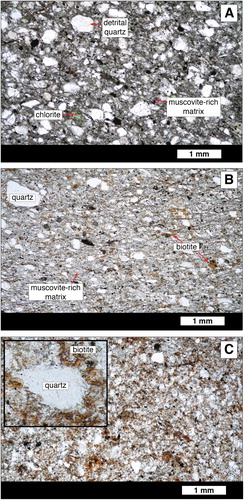
The Greenland Group greenschist facies assemblages are overprinted by a zone of albite-epidote hornfels facies rocks at a distance of 1300 and 1800 m west of the Dunphy Granite-Greenland Group contact (). These greenish rocks retain bedding and detrital textures but have been more thoroughly recrystallised than the Type I rocks (B). Metamorphic biotite is present. Semi-quantitative EDS analyses confirm that albite is present, except for a mineralised specimen at the Caledonian mine site, which contains oligoclase.
The hornfelsic rocks within ∼1300 m of the granite-Greenland Group contact () are distinctly browner than either the albite-epidote hornfels facies or greenschist facies rocks. Relict detrital quartz grains are present but the metamorphic mineralogy consists of muscovite, quartz, oligoclase (confirmed by EDS), chlorite and biotite (C). In some cases, oligoclase contains relict albite cores. Biotite is abundant, is randomly oriented around quartz grains and imparts the overall brown colour to the rock. Ilmenite, rutile, apatite, K-feldspar, pyrite, titanite, zircon and monazite occur in minor quantities (<1%). Spotted hornfels textures occur in some meta-argillite rocks. The spots are typically composed of fine-grained muscovite after what may have been cordierite.
The true thickness of the metamorphic aureole is interpreted to be significantly smaller than the apparent thickness (∼2000 m) along the river. The granite pluton is likely to occur shallowly beneath the Greenland Group carapace downriver of the mapped contact and if the orientation of the contact is projected to match the 15o west dip measured at the Greenland Group-Dunphy Granite contact, then the aureole has a true width closer to about 600 m ().
Mineralisation
The northernmost historic mine in the Reefton Goldfield, the Caledonian Mine, occurs within the area mapped as albite-epidote hornfels facies zone rocks. It lies in east-facing strata and is subparallel to the east hinge of a major syncline axis (). Historic plans and reports show that ore was excavated from four levels before being truncated by a fault (Henderson Citation1917) (). Underground descriptions provided by Henderson (Citation1917) indicate mineralisation occurred along a fault zone. Henderson (Citation1917) also mentions, for one section (p.131), that mineralisation occurred in a 3.7- m-wide elongate zone that consisted ‘ … of a “mullock reef”- that is, small leaders of quartz, which in this case carried visible gold, thickly interspersed through slate and sandstone’. This is similar to many other mineralisation occurrences in the goldfield that are demonstrably located in brittle fault zones (Christie and Brathwaite Citation2003; MacKenzie et al. 2014; Shand et al. Citation2015; Allibone et al. Citation2018). The ore body in the central portion of the Caledonian mine workings was up to 0.9 m wide by 55 m long and dipping steeply eastwards (Henderson Citation1917). The mine was extended to No. 2 South Larry’s mine, which was reported to comprise discontinuous gold-bearing quartz stringers interspersed with meta-greywacke and meta-argillite (Henderson Citation1917). The mine closed in 1879 by which time it had yielded 164.5 kg Au (Barry Citation1993). The workings have now largely collapsed, except for a portion of the Argyle Tunnel.
Figure 5. Map (A) and cross section (B) of through Caledonian Mine, adapted from Henderson (Citation1917). The historic underground workings are projected to the surface on the map. The mineralised zone dips steeply to the east but the workings are projected onto a plane in the cross section. Mineralised zones are indicated in red. The map underlay is from Google Earth. Grid references are for the Topo50 2000 Map series.
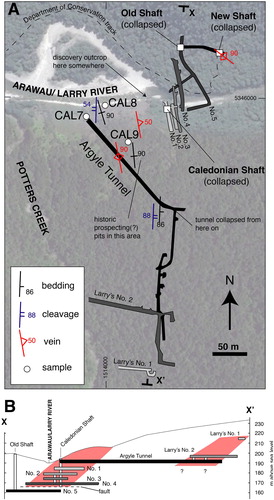
Although the mineralised zone is currently very poorly exposed, arsenopyrite and/or gold-bearing samples were located at river level in the south bank and in several small old prospecting (?) pits on the southern side of the valley (). It is unclear whether these occurrences represent the main mineralised zone or if they are from subsidiary splays, but the south bank occurrence is close to the area where the deposit was discovered (Henderson Citation1917). The mineralised quartz veins occur as veinlets up to 10 cm in width subparallel to bedding. Some veins are dark-coloured and contain visible pyrite and arsenopyrite, whereas others are white and sulphide-free. Mineralised veins contain small mm to cm scale patches of hornfelsed argillite that are mica-rich where they meet the quartz vein (B). Arsenopyrite and pyrite are commonly associated with the quartz veins, and occur in fractures (C) or as fractured grains (D). Patches of pyrite and quartz also occur within brecciated and silicified hornfelsic host rock (E), which is cut by small quartz veins (F). The quartz veins contain clots of hydrothermal metals, sulphides, phosphates and silicates (A–C). Gold is associated with very coarse (up to 1 cm) arsenopyrite, pyrite, chalcopyrite and galena (A, 7C and A). Arsenopyrite, which is the main sulphide, contains fractures that host quartz, minor galena and molybdenite. Stylolites contain biotite, oligoclase, chlorite after biotite, apatite, pyrite, molybdenite and native silver (possibly from gold) (B, 8B and C). Barite forms mm-wide veins that cut through the mineralised assemblages. Semi-quantitative EDS analyses indicate no discernable zoning within the sulphides.
Figure 6. A, A hand specimen quartz vein containing clasts of hornfelsed Greenland Group from within the Argyle Tunnel. B and C, Close up details showing dis-equilibrium textures with the hornfelsed Greenland Group wall rock are highlighted. Sample is from location CAL8 (see ). D, Arsenopyrite grains are coarse, and grains with originally prismatic morphologies are brecciated. Sample is from location CAL8. E, Polished hand specimen showing pyrite and quartz occurring within brecciated Greenland Group (Grn. Grp.), which is also cut by numerous small quartz veins. Sample is from location CAL9. F, Close-up of the brecciated area in E.
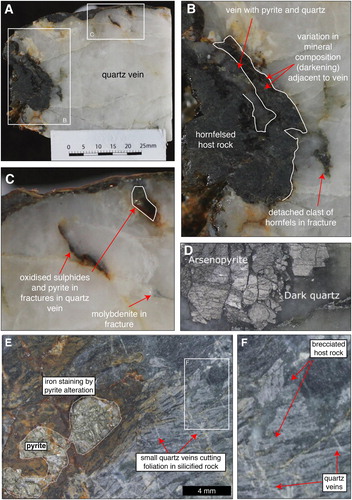
Figure 7. A, Polished hand specimen with a large area of arsenopyrite with minor, pyrite, apatite and gold occurs in a quartz vein collected from the Caledonian mine site. Sample CAL8E. B, Polished hand specimen showing the occurrence of gold, arsenopyrite, chalcopyrite and galena in a grey quartz vein. C, This BSE image shows the range of silicates, sulphides and elements that occur within hornfelsed material within a quartz vein. Sample CAL8E.

Discussion
Mineralisation at the historic Caledonian gold mine area is similar to assemblages documented elsewhere in the Reefton goldfield, which are also located on fault zones (Gage Citation1948; Christie and Brathwaite Citation2003; MacKenzie et al. Citation2014; Shand et al. Citation2015; Hamisi et al. Citation2017; Allibone et al. Citation2018). However, the Caledonian mine is located in ∼378–370 Ma hornfels facies rocks rather than the typical regional Type 1 greenschist facies Greenland Group rocks. Gold mineralisation in the Caledonian area could: pre-date Dunphy Granite contact aureole formation, have occurred during aureole formation, or it post-dates aureole formation. Option 2 seems unlikely since the granite-Greenland Group contact would be the prime location for magmatic fluids to interact with the host rock but is completely unmineralised (). The question therefore is: Does gold mineralisation at the Caledonian mine pre- or post-date the formation of the Dunphy Granite contact aureole?
If mineralisation occurred before Dunphy Granite intrusion, then the recrystallisation of the immediate host rock mineralogies from greenschist to hornfels facies textures requires that the mineralised zone was also thermally affected. However, instead of veins in equilibrium with the host Greenland Group (e.g. veins having similar grain sizes to the Greenland Group, or being composed of metamorphic quartz, or sulphides replaced or recrystallised), the occurrence
of fine-grained hornfelsed clasts within coarsely brecciated quartz veins (A and B);
the mica-rich Greenland Group at the immediate vein margins (CitationFigure 6B);
the presence of small quartz veins cutting across brecciated mineralised Greenland Group (E and F); and
the occurrence euhedral pyrite (D and 8A). and gold and galena grains (B) within brecciated but euhedral arsenopyrite
Figure 8. A, Backscattered electron image CAL8E contains arsenopyrite enclosing gold inter-grown with galena. B, This back scattered electron image shows the occurrence of galena and prismatic pyrite within a brecciated arsenopyrite. C, Galena, molybdenite and recrystallised quartz occur in fractures in an arsenopyrite grain. Note that quartz in these images appears black due to the low atomic weight compared to the sulphides and gold.
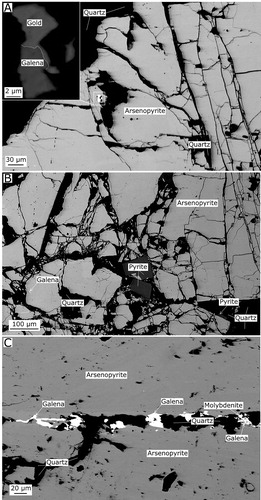
Conclusion
Awarau/Larry River valley contains Greenland Group meta-argillites and meta-greywackes that have been contact metamorphosed by the Late Devonian (378–370 Ma) Dunphy Granite. Three metamorphic facies are recognised: green-hued meta-greywacke and meta-argillite distal to the granite texturally and mineralogically indistinguishable from the common regional greenschist facies (Type 1) Greenland Group; albite-epidote hornfels assemblages between 2000 and 1300 m from the Dunphy Granite-Greenland Group contact; and hornblende hornfels facies rocks between 1300 m and the Greenland Group-Dunphy Granite contact. The Caledonian goldmine is located on a fault zone within hornfelsed rocks. The mineralised rocks are fault hosted and have a complex paragenesis that involved the formation of quartz veins accompanied by gold, arsenopyrite, pyrite, galena, chalcopyrite, biotite, oligoclase, chlorite, apatite, pyrite and, perhaps, silver. Field and petrographic observations are interpreted as indicating that gold mineralisation post-dated formation of the Dunphy Granite contact aureole, which means this gold deposition event occurred after 378–370 Ma.
Acknowledgements
We thank OceanaGold for somewhere to cut the rocks up and the University of Otago Geology Department for supporting the costs of fieldwork. A MBIE grant administered through GNS Science supported this research. Comments from Marco Brenna, Tony Christie, Patti Durance and an anonymous reviewer improved the work.
Disclosure statement
No potential conflict of interest was reported by the authors.
ORCID
James M. Scott http://orcid.org/0000-0001-5185-6261
References
- Adams CJ, Kelley S. 1998. Provenance of Permian-Triassic and Ordovician metagraywacke terranes in New Zealand: evidence from 40Ar/39Ar dating of detrital micas. Geological Society of America Bulletin. 110:422–432. doi: 10.1130/0016-7606(1998)110<0422:POPTAO>2.3.CO;2
- Adams CJD, Harper CT, Laird MG. 1975. K-Ar ages of low grade metasediments of the Greenland and Waiuta groups in Westland and Buller, New Zealand. New Zealand Journal of Geology and Geophysics. 18:39–48. doi: 10.1080/00288306.1975.10426345
- Allibone A, Blakemore H, Gane J, Moore J, MacKenzie D, Craw D. 2018. Contrasting structural styles of orogenic gold deposits, Reefton Goldfield, New Zealand. Economic Geology.
- Barry JM. 1993. The History and Mineral Resources of the Reefton Goldfield. Resource Information Report 15, Ministry of Commerce.
- Bierlein FP, Christie AB, Smith PK. 2004. A comparison of orogenic gold mineralisation in central Victoria (AUS), western South Island (NZ) and Nova Scotia (CAN): implications for variations in the endowment of Palaeozoic metamorphic terrains. Ore Geology Reviews. 25:125–168. doi: 10.1016/j.oregeorev.2003.09.002
- Bradshaw MA. 1995. Stratigraphy and structure of the Lower Devonian rocks of the Waitahu and Orlando Outliers, near Reefton, New Zealand, and their relationship to the Inangahua Outlier. New Zealand Journal of Geology and Geophysics. 38:81–92. doi: 10.1080/00288306.1995.9514640
- Christie AB, Brathwaite RL. 2003. Hydrothermal alteration in metasedimentary rock-hosted orogenic gold deposits, Reefton goldfield, South Island, New Zealand. Mineralium Deposita. 38:87–107. doi: 10.1007/s00126-002-0280-9
- Cooper RA. 1974. Age of the Greenland and Waiuta Groups, South Island, New Zealand (note). New Zealand Journal of Geology and Geophysics. 17:955–962. doi: 10.1080/00288306.1974.10418235
- Cooper RA. 1989. Early Paleozoic terranes of New Zealand. Journal of Royal Society of New Zealand. 19(1):73–112. doi: 10.1080/03036758.1989.10426457
- Dickie JE, Scott JM, Sagar MW, Blakemore H. 2018. Cretaceous igneous-related mineralisation in the Reefton Goldfield, New Zealand. New Zealand Journal of Geology and Geophysics. doi: 10.1080/00288306.2018.1529684
- Gage M. 1948. The geology of the Reefton Quartz Lodes. New Zealand Geological Survey Bulletin. 42.
- Groves DI, Goldfarb RJ, Robert F, Hart CJ. 2003. Gold deposits in metamorphic belts: overview of current understanding, outstanding problems, future research, and exploration significance. Economic Geology. 98:1–29.
- Hamisi J, MacKenzie D, Pitcairn I, Blakemore H, Zack T, Craw D. 2017. Hydrothermal footprint of the Birthday Reef, Reefton goldfield, New Zealand. New Zealand Journal of Geology and Geophysics. 60:59–72. doi: 10.1080/00288306.2016.1274332
- Henderson J. 1917. The geology and mineral resources of the Reefton Subdivision, Westport and North Westland Division. Department of Mines, New Zealand Geological Survey Bulletin.
- Kutsukake T. 1988. The Britannia Granite pluton in the Karamea Batholith, South Island, New Zealand. New Zealand Journal of Geology and Geophysics. 31:275–286. doi: 10.1080/00288306.1988.10417777
- Laird MG, Shelley D. 1974. Sedimentation and early tectonic history of the Greenland Group, Reefton, New Zealand. New Zealand Journal of Geology and Geophysics. 17:839–854. doi: 10.1080/00288306.1974.10418229
- Leach T, Corbett GJ, Magner P, McKenzie M. 1997. A geological model for gold mineralisation at Reefton, New Zealand. In: 1997 New Zealand Minerals and Mining Conference, Crown Minerals, Ministry of Commerce (pp. 159–165).
- MacKenzie D, Craw D, Blakemore H. 2014. Multi-stage ore formation at the Reefton goldfield, New Zealand. AusIMM New Zealand Branch Annual Conference.
- Milham L, Craw D. 2009. Two-stage structural development of a Paleozoic auriferous shear zone at the Globe-Progress deposit, Reefton, New Zealand. New Zealand Journal of Geology and Geophysics. 52:247–259. doi: 10.1080/00288300909509889
- Mortimer N, Nathan S, Jongen R, Kawachi Y, Ryland C, Cooper AF, Stewart M, Randall S. 2013. Regional metamorphism of the Early Palaeozoic Greenland Group, South Westland, New Zealand. New Zealand Journal of Geology and Geophysics. 56:1–15. doi: 10.1080/00288306.2012.734830
- Muir RJ, Ireland TR, Weaver SD, Bradshaw JD. 1996. Ion microprobe dating of Paleozoic granitoids: Devonian magmatism in New Zealand and correlations with Australia and Antarctica. Chemical Geology. 127(1):191–210. doi: 10.1016/0009-2541(95)00092-5
- Muir RJ, Ireland TR, Weaver SD, Bradshaw JD, Waight TE, Jongens R, Eby GN. 1997. SHRIMP u-Pb geochronology of Cretaceous magmatism in northwest Nelson-Westland, South Island, New Zealand. New Zealand Journal of Geology and Geophysics. 40:453–463. doi: 10.1080/00288306.1997.9514775
- Nathan S. 1978. Buller-Lyall. Geological Map of New Zealand. 1: 63360 sheet S31-S32. New Zealand Geological Survey.
- Nathan S, Rattenbury MS, Suggate RP. 2002. Geology of the Greymouth Area: 1: 250 000. Institute of Geological & Nuclear Sciences.
- Palmer MC, Scott JM, Muhling JR, Kennedy AK. 2015. Carboniferous metamorphism and partial melting of the Greenland Group in the Jackson River valley, south Westland. New Zealand Journal of Geology and Geophysics. 58:22–32. doi: 10.1080/00288306.2014.982661
- Pirajno F, Bentley PN. 1985. Greisen-related scheelite, gold and sulphide mineralisation at Kirwans Hili and Bateman Creek, Reefton district, Westland, New Zealand. New Zealand Journal of Geology and Geophysics. 28:97–109. doi: 10.1080/00288306.1985.10422279
- Rattenbury MS, Stewart M. 2000. Structural setting of the Globe-Progress and Blackwater gold mines, Reefton goldfield, New Zealand. New Zealand Journal of Geology and Geophysics. 43:435–445. doi: 10.1080/00288306.2000.9514900
- Ritchie TW, Scott JM, Muhling JR, Kennedy AK. 2015. Cretaceous metamorphism, magmatism and shearing in the Waipuna Valley, directly south of the Reefton Goldfield. New Zealand Journal of Geology and Geophysics. 58:1–15. doi: 10.1080/00288306.2014.992444
- Roser BP, Cooper RA, Nathan S, Tulloch AJ. 1996. Reconnaissance sandstone geochemistry, provenance, and tectonic setting of the lower Paleozoic terranes of the West Coast and Nelson, New Zealand. New Zealand Journal of Geology and Geophysics. 39:116. doi: 10.1080/00288306.1996.9514690
- Scott J, Muhling J, Fletcher I, Billia M, Palin JM, Elliot T, Günter C. 2011. The relationship of Palaeozoic metamorphism and S-type magmatism on the paleo-Pacific Gondwana margin. Lithos. 127:522–534. doi: 10.1016/j.lithos.2011.09.008
- Shand F, Scott J, Blakemore H. 2015. Structural controls and mineralising fluids at the Big River South-St George Au deposits, Reefton. AusIMM New Zealand Branch Annual Conference. 395–404.
- Shand FCG, Scott JM. 2016. The origin of Cu-Mo mineralisation at Cascade Creek, Westland. AusIMM New Zealand Branch Annual Conference 10p.
- Tulloch AJ, Rabone SDC. 1993. Mo-bearing granodiorite porphyry plutons of the Early Cretaceous Separation Point Suite, west Nelson, New Zealand. New Zealand Journal of Geology and Geophysics. 36:401–408. doi: 10.1080/00288306.1993.9514586
- Tulloch AJ, Ramezani J, Kimbrough DL, Faure K, Allibone AH. 2009. U-Pb geochronology of mid-Paleozoic plutonism in western New Zealand: implications for S-type granite generation and growth of the east Gondwana margin. Geological Society of America Bulletin. 121:1236–1261. doi: 10.1130/B26272.1
- Turnbull R, Tulloch A, Ramezani J, Jongens R. 2016. Extension-facilitated pulsed SIA-type “flare-up” magmatism at 370 Ma along the southeast Gondwana margin in New Zealand: insights from U-Pb geochronology and geochemistry. Geological Society of America Bulletin. 128:1500–1520. doi: 10.1130/B31426.1
- van der Meer QH, Storey M, Scott JM, Waight TE. 2016. Abrupt spatial and geochemical changes in lamprophyre magmatism related to Gondwana fragmentation prior, during and after opening of the Tasman Sea. Gondwana Research. 36:142–156. doi: 10.1016/j.gr.2016.04.004
- van der Meer QHA, Scott JM, Waight TE, Sudo M, Scherstén A, Cooper AF, Spell TL. 2013. Magmatism during gondwana break-up: new geochronological data from Westland, New Zealand. New Zealand Journal of Geology and Geophysics. 56:229–242. doi: 10.1080/00288306.2013.826699
- Waight TE, Weaver SD, Muir RJ. 1998. Mid-Cretaceous granitic magmatism during the transition from subduction to extension in southern New Zealand: a chemical and tectonic synthesis. Lithos. 45:469–482. doi: 10.1016/S0024-4937(98)00045-0

